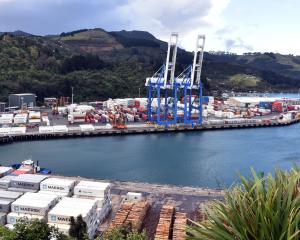Port Otago does not expect to be forced into a race with competitor Lyttelton Port of Christchurch (LPC) over their respective plans to deepen shipping channels, with the possibility of larger container vessels coming to New Zealand in the near future.
While earthquake-damaged LPC yesterday outlined a $1 billion, 30-year infrastructure rebuild plan, Port Otago remains confident it can implement its own channel-dredging and deepening plans in a timely manner.
Port Otago is yet to announce when it will begin its already consented dredging programme.
Port Otago chief executive Geoff Plunket said because Tauranga might in two to three years be ready to host the large 6500 TEU (twenty-foot container equivalents) ships, he did not think Port Otago and LPC would get into a race.
''No. This won't make any difference to us,'' Mr Plunket said.
Port Otago was still to announce its final decision on dredging, with Mr Plunket highlighting that aside from contracting out the job, Port Otago had its own dredge, consents were in place and several timeframes were still available.
''We have a lot of flexibility and, over time, [it would be] low cost,'' he said.
Maersk Line managing director Gerard Morrison yesterday said while having met Mr Plunket earlier this month, Maersk had no expectations Port Otago would bring forward its dredging programme.
''We will look at it in due course,'' he said.
Mr Plunket said LPC had ''a lot on its plate'', other than just considering dredging.
The extent and scope of work at LPC was outlined yesterday by its chief executive Peter Davie , who released a ''Port Lyttelton Plan'', which he estimated would cost $1 billion and take up to 30 years to complete.
''To simply repair or rebuild what was there would be a failure on our part. We must ensure that we are able to continue to meet the needs of the region now and in the future,'' Mr Davie said in a statement.
Critical to LPC remaining a ''key piece of the region's infrastructure'' was its ability to manage much larger ships, so New Zealand remained a primary freight route.
Some of the key components of Mr Davie's plan include moving eastward some general cargo activity, and preparing for increased container volumes with further land reclamation east of the existing port, which would allow for the relocation of a new, larger, container terminal. There would also be a staged repair of the port's earthquake damage and new building activity, while remaining fully operational, he said.
''Over 99% of imported and exported goods enter or exit New Zealand via a port and volumes are growing rapidly. It is essential that we grow to meet the demand.''





